*This post may contain affiliate links. This means we may make a commission if you purchase an item using one of our links*
If you’ve found yourself on this page you’re likely in the market for a cheap or just a fairly affordable telescope to help yourself, a friend or family get into astronomy.
Astronomy is a wonderful thing, the universe is crazily vast and the number of things you can see by using your eyes alone pales in comparison to what specifically designed technology from telescopes and if you’ve found yourself here, you’d rather not break the bank in order to experience the vastness and beauty of the cosmos around us.
In and around the $300 price range, you shouldn’t expect to find the most powerful of devices but, that doesn’t mean quality scopes can’t be found. In this article I’ll be going some of the best telescopes that you can find for under $300 so that the decision making process doesn’t take up as much time for you to get started in the hobby of stargazing!
In A Hurry? Check Out Our Best 3 Options Below!
Table of Contents





1. SkyWatcher S11600 Traditional Dobsonian 6-Inch
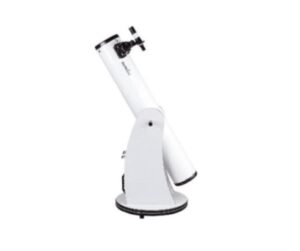
The Sky-Watcher 6 inch is literally right at the top end of this list in terms of pricing being just under $300 but, at this price you’ll also be getting access to the most powerful device on this list too.
The specs of the SkyWatcher is 152mm aperture (newtonion reflector design), 1200mm focal length which leads to a focal ratio of f/8.
What these specs translate to in practical use is a theoretical maximum magnification of around 300x. What this means is that you’ll be able to see Jupiter in greater detail than most of the telescopes on this list but, you still won’t be able to make out any detail on its moons.
You’ll be able to observe saturn at pretty good detail too. Nebulae and other galaxies will also look good through the scope, provided you use it in a low light pollution environment.
The accessories included in the box are 25mm (48x) and 10mm (120x) 4-element plods 1.25″ eyepieces, 2” single-speed rack-and-pinion Focuser with 1. 25” adaptor and a rocker-mount with Teflon bearings and tension Clutch for altitude.
Due to the scopes high focal length, the included eyepieces, although not that great, will allow you to see reasonably detailed images of the moon, see a few nebulae and star clusters, which of course will be mesmerizing but, in order to get the most out of the scope, it’s probably best that you invest in a Barlow lens or in a smaller more powerful eyepiece.
The weight of the skywatcher 6″ is just under 15 kg whilst the dimensions are 49 x 27 x 14 inches, which doesn’t make it the smallest of systems to get, being well over a meter in height however, it’s weight and size in general isn’t all that bad and should be fairly easy to move.
Customers of the device have found it to be solid however, they do believe that the bigger 8″ model is probably worth the extra $100 investment.
Nevertheless, at the lower than $300 cost, the Sky-Watcher 6″ is a very very good telescope.
Click Here To Check The SkyWatcher S11600 Traditional Dobsonian 6-Inch’s Prices On Amazon
2. Zhumell Z114
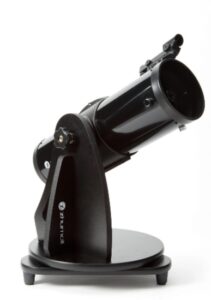
The Zhumell Z114 is an mid-range entry level reflector telescope from Zhumell, so to speak, with its specs not really being the most amazing but, generally worth it considering how much you’d be paying for it, roughly around the $150 mark.
The specs for the Z114 are decent for the price with the device having a 114mm aperture, 456mm focal length leaving you with a focal ratio of f/4.
What this means is that Z114 has a maximum magnification of 224x which means with it you will be able to see quite a lot of things such as Jupiter and its moons which’ll look like small dots, Saturn and its rings, a few nebula, galaxies and star clusters.
Of course none of these objects will be insanely detailed but, you will be able to see them fairly comfortably due to the power.
Don’t expect super closeups of the planets or being able to view planets that are further away or smaller in much detail, like Mars for example but, for the modest price of the scope, the theoretical max power isn’t all that bad.
As for the accessories included in the box, you’ll get a 17mm (27x) and 10mm (46x), a red dot finder and the Dobsonian mount which will swivel side to side without much of hitch.
Although the eyepieces are nice, you honestly shouldn’t expect to observe too much in terms of planetary objects besides the moon with it because seeing Jupiter and Saturn will require around 180x magnification for a nice look.
The weight of the Z114 is 4.47kg with dimensions being 47 x 34.3 x 41.3 cm which obviously a very portable and lightweight system, if that’s what you’re looking for.
The biggest set backs for the scope are it’s not very powerful reflective lens, the mediocre eyepieces, it will need to be maintained often due to the optics being exposed and collimating the device likely will be a pain to sort which does appear to be a big problem for some users.
Besides these points, at the price point it’s at and the portability of the scope, it’s a very solid pick for under $300 and of course we’ll under $200 too.
Click Here To Check The Zhumell Z114’s Prices On Amazon
3. Zhumell Z130
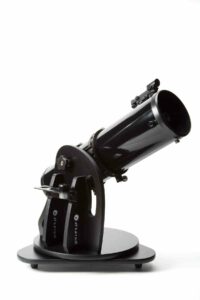
The Zhumell Z130 is a solid beginner telescope, only setting you back around $200 to purchase while also being a fairly compact system too. In terms of the specifications it has, the aperture is 130mm, the focal length at 650mm which results in a focal ratio of f/5.
What this translates to in terms of practical use is that you’ll be able to observe space at a maximum magnification of 256x, which will allow you to view quite a few celestial objects such as saturn and it rings, Jupiter as well as it’s three moons although only as 3 bright dots. You’ll be able to observe clusters like the hercules clusters, the Swan nebula and so on.
In short you’ll be very impressed with this device if it’s your first one but, you’ll definitely want to consider looking into more powerful devices down the road if you’re in the market for significantly more detailed and powerful telescope.
As for the accessories you’ll get within the box, it’ll be 2 eyepieces, a 25mm (26x) and a 10mm (65x), a red dot finderscope, an eyepiece rack and a Dobsonian mount. As for how practical the two eyepieces are, you’ll only realistically be able to see the moon with some decent detail but, everything else won’t really be too great.
You’ll definitely want to consider looking into a 2 to 3x Barlow lens or smaller mm eyepieces.
As for it’s weight and dimensions, the Z130 weighs in at around 10kg whilst the dimensions are 24 x 18 x 18.5 inches which means it’s a little bit too big to be carried in a backpack but, it’s still fairly portable and can easily be carried around in a bigger carry-on bag.
For the price and the power it displays, the Zhumell Z130 is a very solid entry level pick for astronomers on a budget and definitely one that I’d personally say you can’t go wrong with.
Click Here To Check The Zhumell Z130’s Prices On Amazon
4. Orion 10022 Starmax 90 Tabletop MAK-CAS (Hybrid)
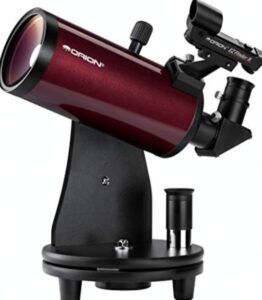
The Orion Starmax 90 is a slightly different designed telescope than the other 3 options as it’s a compound telescope with Maksutov-Cassegrain design.
This means that it will be slightly more expensive than the other options with a weaker spec list. However, there are quite a few benefits to this type of telescope such as not needing to maintain it as often as a reflector design, no issues with chromatic aberration and a significantly smaller frame over it’s competitiors without any real loss in quality.
The specs of the Starmax 90 aren’t necessarily what you would call the greatest with the aperture being 90mm, the focal length being 1200mm f/13.8
This means that the theoretical maximum magnification of the scope is only at 177x which means you will be able to view jupiter, saturn and quite a few nebulaes but it will only be at a very minimal detail and a fair distance away from the object you want to observe. In short it definetly isn’t the most powerful device you can get for around $200.
As for the accessories included in the box, 25mm and 10mm 1.25″ eyepieces which allow for a magnification of 50x and 125x. This is pretty good considering the power of the device but, for the maximum performance you’ll only need to get a 7mm eyepiece, which shouldn’t cost too much of you want to reach the Starmax’s max capacity.
You’ll also get an EZ Finder II reflex sight and a diagonal mirror which will make it convenient to look through the scope without straining due to the small dimensions of the scope. The Starmax 90 is inherently a tabletop device but, the tube can easily be removed allowing for you to place it on a tripod if that’s what you want to do.
As I said, the scope is a very lightweight and portable weighing in at 2.95kg and the dimensions being 49.5 x 26.7 x 26.7 cm will make it a very easy system to travel with if you plan to do so, mostly to get away from light pollution in order to get the most mesmerising views.
Although the power of the scope isn’t the greatest, many people really enjoyed the portability of the device. So, if you’d much rather invest in a portable piece of kit, the Starmax 90 is a great option for under $300.
Click Here To Check The Orion 10022 Starmax 90 Tabletop MAK-CAS (Hybrid) ’s Prices On Amazon
Check Out Orion’s Official Pricing!
5. Orion 8944 SkyQuest XT6 Classic Dobsonian Telescope
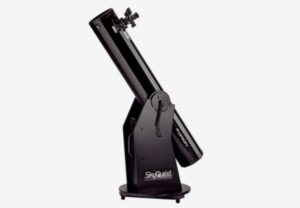
This is another telescope, much like Skywatcher which is at the top end of this price bracket, being roughly $300. The reason why it’s expensive is once again due to its superior power over the competition.
The SkyQuest XT6 has a 150mm aperture, a focal length of 1200mm which translates to a focal ratio of f/8, which is a very solid spec list for the price.
What this translates to in terms of practical use is that the max theoretical magnification will be 295x, which is slightly weaker than the SkyWatcher 6″ but, you’ll essentially be able to view everything in the same quality as it.
You’ll be able to get a nicely magnified image of Jupiter and make out its moons, Saturn and its Cassini rings should be more than visible, Mars and even Pluto can be observables through this scope. Of course star clusters, nebulae and galaxies will be viewable too although it will be significantly more blurry than let’s say a 10inch telescope but that’s too be expected right?
The accessories included in the box are a 1.25-inch rack-and-pinion focuser, an EZ Finder II reflex sight, collimation cap, and a 25mm (48x) Sirius Plossl telescope eyepiece. If you opt to get the kit with it, you’ll also receive a 2x Barlow lens which will essentially double the magnification of the 25mm eyepiece.
The equipment you’ll receive out of the box should allow you to see Jupiter, Saturn and even a few clusters but the details will be quite minimal until you decide to get some upgraded eyepieces.
The SkyQuest weighs in at 16kg, which is a little heavy but, certainly more than manageable to move around. It’s 48.7 x 16.3 x 13.6 inches may however, make it a little annoying to move around so getting a pair of wheels to help you would be in your best interests.
All in all the majority of individuals who did buy it found it to be a very solid entry level telescope and even first time scope so getting the XT6 shouldn’t prove a burden at all if you decide to pick it up.
Click Here To Check The Orion 8944 SkyQuest XT6 Classic Dobsonian Telescope’s Prices On Amazon
==>Click Here To Check Orion SkyQuest XT6’s Pricing On Orion’s Website!
6. Meade Lightbridge Mini 114
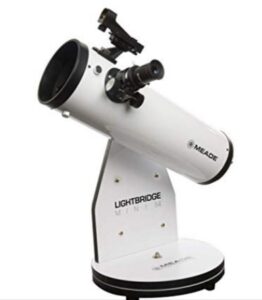
The MEADE Lightbridge Mini 114 is a scope that will cost around $140 – $170 depending on where you shop. The power of the device is also fairly modest too being the same as the Z114 mentioned above.
The aperture of the scope is 114mm as the name would suggest, the focal length is 450mm which leave you with a focal ratio of f/3.95.
This means that the maximum magnification of the device is only 231x, which isn’t the greatest power on this list however, it will be more than capable of showing you some of the closer and bigger planets, star clusters, galaxies but of course, the detail and the number of celestial objects will be limited. It should go without saying that the moon will look great through the scope.
The accessories included in the box are 2 eyepieces at a 26mm (17x) and 9mm (50x), a Red Dot Finder, a software DVD and the Dobsonian mount that’ll come with device.
The eyepiece doesn’t allow for much power out of the scope, mostly because of the low focal length but, this does mean if the things you’ll be able to see with mini 114 will be really limited. So it’s going be pretty much necessary to purchase some higher powered eyepiece or a Barlow lenses.
The scope weighs in at 4.9kg and has fairly compact dimensions at 31.1 x 31.1 x 61 cm which makes it a easy enough scope to travel with if that’s an important factor when making a purchase. .
All in all, the device is regarded as a solid beginner level system and doesn’t seem to have very many issue besides maybe the device being relatively weak. Of course as it’s a reflector scope and has a low focal ratio, you will need to re-align the system quite often and because the optics are exposed, it will also require regular maintenance.
Click Here To Check The Meade Lightbridge Mini 114’s Prices On Amazon
7. Meade Lightbridge Mini 130
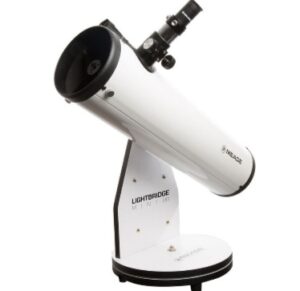
The Meade Lightbridge Mini 130 is just an upgraded variant of the 114 so of course the differences between the aren’t too great. It’s pretty much like the relationship between the Zhumell Z114 and Z130.
This device will cost you a bit more than the 114 ranging around the $200 mark but, I definitely think it’s worth the extra 50 bucks if you’re keen on the extra details you’ll be able to get out of the scope.
The specs of the mini 130 is a 130mm aperture, 650mm focal length which results in a focal ratio of f/5. The scope is also a reflector based one meaning the images will look great through the lens however, the alignment and maintenance of the exposed optics may be a little bit of a burden.
As for what the specs mean, the theoretical magnification of the mini 130 is 256x which basically corresponds with what I said about the Z130. You’ll be able to observe jupiter and its moons at pretty decent detail, saturn and its rings will be detailed too as well as being able to observe multiple star clusters, nebulae and galaxies.
The accessories you’ll receive in the box contains the same two eyepieces found in the mini 114, a 26mm (25x) and a 9mm (72x), a software DVD, a few books, a red dot finder and of course the same Dobsonian mount.
Of course with increased specs, the eyepieces do produce better results but, you’ll still need to look into upgrading them to get the best views through the mini 130.
The device weighs in at 6.17kg with dimensions at 31.1 x 31.1 x 66 cm which still makes it very portable system despite the slightly heftier weight. If you’re looking for portabililty and being able to carry a telescope in your backpack, the mini 130 is genuinely a great pick for under $300.
The Meade Lightbridge Mini 130 is a very solid device for the price with decent upgrades over the 114. If your budget doesn’t stretch as far the $300 mark exactly, at $200, this system is solid but, as is obvious, the lower pricing doesn’t make it the most powerful scope you can buy on this list.
Click Here To Check The Meade Lightbridge Mini 130’s Prices On Amazon
8. Celestron 31045 AstroMaster 130EQ Reflector Telescope
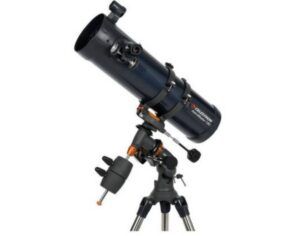
The astromaster 130EQ is a scope that will set you back around $150 – $200 and is another reasonably powerful scope that’s worth looking into for under $300.
The astromaster’s specifications include a 130mm aperture, a 650mm focal length which leaves us with a f/5 focal ratio, which is pretty standard specs list for the price.
What this translates to is a 256x max theoretical magnification just like the meade mini 130 and the Zhumell Z130. This also means that it’ll see the same things as those two scopes with roughly the same amount of detail too.
So yes you’ll be able to view Jupiter and just about make out the moons, Saturn and its rings will be visible, multiple star clusters, galaxies and nebulae will be visible at a decent level of detail detail provided you get the maximum power out of the astromaster.
The accessories included in the box are 2 eyepieces at 20mm (33x) and 10mm (65x), a finderscope, a tripod with a deluxe accessory tray, a DVD that shows a database of 10k objects and of course the German equatorial mount.
The accessories, much like the other 3 similar scopes will generally only be useful for viewing the moons and a few planets, although not in much detail. This means that once again you will need to invest in some more powerful eyepieces or a Barlow lens to get the best views with the astromaster 130EQ.
The device weighs in at 12kg with dimensions of 88.9 x 48.3 x 30.5 cm which makes it a fairly portable device but not to the level of meade mini 130 but, it’s generally slightly cheaper too so deciding between the two will likely just be a toss up on the compactness of each device to be honest.
The Astromaster 130EQ is a great scope for the price however, because of the price there will be a few tools that’ll be missing out of the box which you will need to purchase in order to configure the mirror and what not. Nevertheless, the overall this scope is a good piece of kit.
Click Here To Check The Celestron 31045 AstroMaster 130EQ Reflector Telescope’s Prices On Amazon
9. Celestron Inspire 100AZ Telescope
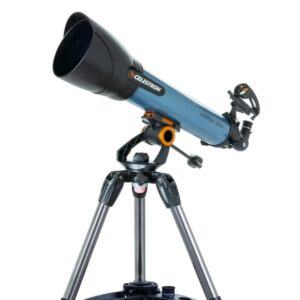
The inspire 100AZ is a refractor telescope that will cost you around $190 – $230. Being a refractor telescope, it’s quite different from all the other scopes I’ve mentioned on this list which are all so far reflector and one compound scope.
What this means is that you will have to deal with a few major issue such as chromatic aberration and not being able to see certain types of lightwaves but, it also has a fair few benefits.
The benefits include lower maintenance as the optics are enclosed in the tube, you won’t need to collimate the system as much because the device is more sturdy and it’s good for viewing objects on earth unlike most reflective telescopes. So the scope has its pros and cons so, you’ll probably want to weigh them up before picking the 100AZ up.
The specs of the 100AZ include an aperture of 100mm, a focal length of 660mm which results in a focal ratio of f/6.6. What these specifications mean is that the initial magnification will be somewhat big but the maximum theoretical magnification will be around 197x.
This obviously isn’t the greatest of magnifications for the price and the refractor lens will cause quite a bit of aberration still as the focal length isn’t so large as to render the images without distortion nevertheless, you will be able to see Jupiter, Saturn, Mars, nebulae, star clusters and few galaxies with the details being limited if you decide to take this route.
As for the accessories included in the box, you’ll get 2 eyepieces at 20mm (33x) and 10mm (66x) which are both 1.25″, a Red LED flashlight, a tripod and the mount which is easy to move around the scope with a clutch when you want to change the area you want to view.
The weight of the scope is fairly light being just over 9kg but the dimensions are somewhat large at 96.5 x 83.8 x 132.1 cm. I wouldn’t say they’re too big to make it hard to move 100AZ around though. As for travelling with it, you’ll likely be able to fit it into a carry on bag.
The 100AZ is well received when looking at it as a basically a toy for younger astronomers because the specs list would suggest viewing things at good detail won’t be the greatest however, it’s still well received by first time astronomers who just want a capable device for under $300.
Click Here To Check The Celestron Inspire 100AZ Telescope’s Prices On Amazon
10. Celestron PowerSeeker 127EQ Telescope
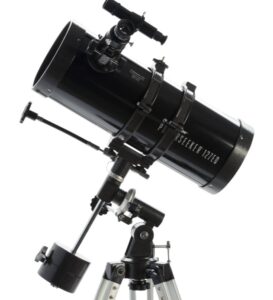
This is another telescope by celestron, they’re basically a front runner in this market, and from the specs list and the price that you can buy it at, it seems like a relatively solid reflector scope. This is yet another affordable 5″ telescope.
The specs of the device is pretty decent with a 127mm aperture, a 1000mm focal length which results in a focal ratio of f/7.87, which once again is reasonably solid for the price. What this means is that the initial magnification of the scope will be quite big and possibly a little disorientating for some people.
The max magnification for the powerseeker is 213x, in terms of useable magnification and although the information about it on amazon claims it can reach a max magnifications of 450x, that’s just way too big for the lens and you won’t be able to see anything at such a high zoom.
In terms of what you’ll be able to see with the scope, essentially everything I’ve mentioned on the other scopes, Jupiter, Saturn, the moon, a few of the other planets but not in too much detail, the andromeda galaxy and few other ones, the Orion nebulae and others and of course a fair few star clusters.
As for what you’ll get in the box, you’ll get 2 eyepieces at 20mm (50x) and a 4mm (250x) (which isn’t very practical for the scope) both at 1.25″, a 1.25″ 3x Barlow lens (this actually is practical when paired with the 20mm eyepiece), a finderscope, a counterweight bar, a German equatorial mount and a CD rom that has a 10,000-object database, printable sky maps and 75 enhanced images.
The device weighs in at 7.71kg with dimensions at 77.4 x 42.2 x 22.8 cm which makes it relatively portable device but if you’re planning on travelling with it on a plane or something, you’ll need to consider looking into a carry-on bag.
The device for the most part appears to be solid from what users have said of it. It’s great for viewing the moon and a few planets and it’s a great price for what it offers but, there are a few issues that people have had with it such as it being hard to set everything up due to the instructions not being all that clear and the finderscope being a bit annoying to deal with.
Click Here To Check The Celestron PowerSeeker 127EQ Telescope’s Prices On Amazon
11. Orion 9024 AstroView 90mm Refractor Telescope
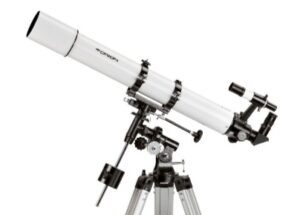
This scope is another refractor telescope but, it’s actually a little weaker yet more expensive than the other refractor scope on this list. However, there is a a pretty good reason why this is the case. This scope will set you back around the $300 mark so it’s not necessarily the cheapest device on this list.
The specs of the AstroView are a 90mm aperture, a 910mm focal length which results in a focal ratio of f/10. What this means is that the chromatic aberration issues won’t be as prevalent as the focal ratio is high but, as you can see the specs aren’t really the greatest you can get for the price so that’s the major compromise you’ll be making with the AstroView.
The max magnifications with this device is only around 177x so the views will be very very limited. Of course you’ll be able to see Jupiter, Saturn and few other planets but, the details will be quite limited.
The moon will look great through the scope and you’ll likely be able to catch a few other deep space objects as long as the light pollution isn’t too much but, yeah the lower aperture does inevitably mean the scope won’t deliver to the same level as the 6 inch devices.
The accessories included in the box are a 25mm (36x) and 10mm (91x) 1.25″ eyepieces, 6×30 finder scope, smooth-adjusting 1.25″ rack & pinion focuser, 90-degree mirror diagonal for comfortable nighttime performance, Starry Night astronomy software a usual manual and few other miscellaneous paperwork.
The eyepieces are pretty good and you literally only need to invest on a 2x or 3x Barlow lens to get the maximum performance with the AstroView, which I do suggest you do.
The AstroView weighs in at 14.5kg with dimensions of 96.5 x 43.2 x 29.2 cm which does once again mean it’s fairly portable but, it’s not a system you can just shove in your backpack. You will need to consider getting a carry-on bag of you’re planning to travel with it.
The device in general is quite weak for the price you’ll be paying for it but, there are a few benefits to it such as the low maintenance and minimal requirements to Collimate too often because of it’s sturdy build and it’s a solid device for checking out some things on earth if you want to be able to do that too.
If you’re willing to compromise a bit of power for a sturdy device, the AstroView isn’t too bad a choice to go for although, I wouldn’t put it at the top of my recommended list.
Click Here To Check The Orion 9024 AstroView 90mm Refractor Telescope ’s Prices On Amazon
Check Out The Official Pricing On Orion!
Conclusion
Hopefully this list has been helpful to you in deciding what the best scopes for under $300 are. If you’re maybe in the market for other devices such as more compact offerings for travel or even the more advanced computerized offerings, I’d suggest checking them out by clicking on the hyperlinks above.
If there’s anything else you’d like to add, feel free to do so in the comments below and it should hopefully help out a few others out there.






